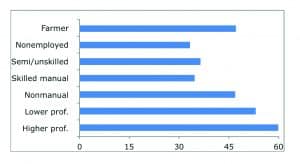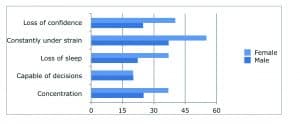It’s that time of year again. The CAO applications deadline has just passed and the mock exams are about to begin for almost 60,000 sixth year students. It’s also the season for commentary on the Leaving Certificate from employers, those in the media and staff in further and higher education institutions. The main criticism centres on how the exam narrows student experience of teaching and learning and prevents them from developing the analytical skills or the ability to think critically that they will need in the workplace, further education and in wider society.
The combination of a high-stakes exam and a hugely competitive points system means there is little emphasis on a more rounded education. Supporters of the existing Leaving Certificate model say that it is a level playing field for students who, regardless of gender, ethnicity or social class background, have an equal chance of success. The evidence for this suggests otherwise, as the following research shows.
What do we know about the Leaving Certificate?
The ESRI’s Post-Primary Longitudinal Study is the most in-depth study of student experiences in second-level education in Ireland. The research followed a cohort of 900 students in 12 case-study schools from entry to secondary school to completion over the period 2001 to 2008. The schools were selected to reflect key factors in how students experience their education, such as subject choice, streaming, and how much support was available to them. By zeroing in on the sixth-year cohort, using a combination of questionnaires and focus-groups, we gained a deep insight into student experiences of school in the months leading up to the Leaving Certificate exam. In any discussions around Senior Cycle reform, the findings are central to understanding the impact of high-stakes exams, such as the Leaving Certificate, on different groups of students. Here are some of the most important findings of our study that offer some guidance of what to avoid if or when the time comes to overhaul the system.
Educational Inequality
High-stakes exams such as the Leaving Certificate reproduce social inequalities because of their disproportionately negative impact on students from lower-income homes. Many argue that students from middle-class households are more familiar with the dominant culture, and so they fare better academically. By contrast, the mismatch between home and school cultures is a disadvantage for working-class students. Our sample of students shows that their experience of their final year leading up to their terminal exam varies according to social class. In sixth year, students begin to find their work more challenging. To cope with this, more middle-class students increase the time spent on their homework and study, with some students spending over four hours per night on homework. Middle-class students are also more likely to take grinds or private tuition outside school to improve their results. In other words, these students appear to use their cultural and financial capital to invest in activities which help them to succeed. Figure 1 shows a clear social class gradient in taking grinds, with extra tuition being much more prevalent among all professional social class groups and farmer groups.

The evidence clearly shows social reproduction, where the most privileged consolidate their position at the expense of the chances of social mobility of those at the bottom. Wealthier sixth-year students have more access to the cultural resources that are needed to make the transition to higher education. Even when we take into account prior performance in school, it is clear that attending a predominantly workingclass school will diminish your chances of going on to higher education. The interviews with sixthyear students highlight how those in middle-class schools tend to draw on insider knowledge gained from siblings and other family members in making their decisions about colleges and types of courses. In contrast, students in more working-class schools whose families have no history of higher education are more reliant on advice from guidance counsellors, teachers and their friends in making a decision. These findings point to the importance of the institution of the school in providing relevant guidance and advice to students who most need it.
Stress and the Leaving Certificate
The escalation in workload and squeeze on free time have a particular impact on young people’s ability to cope, resulting in high levels of exam related pressure, stress and worry. Many reduce their participation in sport, even though those who continued to take part in regular schoolbased sports have lower stress levels than their peers. Girls experience much higher stress levels than boys, with almost 40 per cent of girls reporting losing sleep with worry and over 50 per cent feeling constantly under strain or pressure in the months leading up to the Leaving Certificate (Figure 2). Female students were also more likely to report losing confidence in themselves and having problems concentrating. The findings also show that stress may be passed from one student to another, becoming contagious among particular groups of (often high-performing) girls.

One of the main drivers of this stress was the young people’s own desire to do well. Some of those interviewed spoke about the importance of the Leaving Certificate for their future, believing “it’s the biggest exam you’ll ever do in your life’ (Lang Street, co-ed school, working-class intake) and others felt ‘your whole life depends on it” (Wattle Street, boys’ school, mixed intake). But certain aspects of schooling also influence stress. Students frequently said that teachers who constantly emphasised the importance of the exams were a source of pressure. One student felt that “[teachers] just tell us how bad we are getting on instead of how good we are getting on, you know what I mean. That’s all they do” (Barrack Street, girls’ school, working-class intake). Describing their lack of free-time, another student said that “even the weekends, they’re telling you that you have to study the whole weekend as well” (Barrack Street, girls’ school, working-class intake). Interestingly, students who received more praise or positive feedback from their teachers had lower levels of stress, while some also reported that teachers themselves were stressed about ‘covering’ enough of the curriculum in time for the exams. What do students want?
By sixth year, students appear to recognise the high stakes associated with the Leaving Certificate and in particular the importance of their results for obtaining education, training and employment. This influences their attitudes to teaching and learning as they become highly instrumental in how they approach the exam. Some students, particularly middle-class students, are extremely conscious of doing what it takes to score high grades, which expresses itself as a clear preference for narrowly focussed teaching and learning. During the interviews, students expressed frustration with some teachers who veered off the curriculum:
“Like some teachers kind of go off the point sometimes and just waffle on about pointless things that isn’t on the course and stuff. (Fig Lane, middle-class co-ed school)”.
“Like my Home Ec teacher, she comes in and she knows how to cook, she tells us all about how to make mayonnaise today. That’s not on our course, we don’t care … it’s like too much stuff to do”. (Harris Street, middle-class girls’ school).
The dominant role of the Leaving Certificate determines what knowledge is taught and how it is taught, with a lot of time devoted to exam preparation. This approach neglects subject knowledge not included in the exams and reduces the breadth of the curriculum. With many students wish only to learn exam skills rather than developing higher order cognitive skills, the easiest option for teachers is to ‘teach to the test’.
So what can we take from all these findings? The evidence suggests that the Leaving Certificate creates an environment that encourages students to learn in a more exam-focused and instrumental way. Not only that, despite the view that it offers a level playing field, the Leaving Certificate can exacerbate differences between social groups. Added to this are teachers, who appear to be under increasing pressure to help their students gain grades at the expense of all other educational goals. Recent Junior Cycle reforms and in particular the move towards more continuous school-based assessment have shone a light on the nature and purpose of assessment at senior cycle.
So maybe it’s time to rethink assessment as a way of engaging students and developing their ability to think critically. Maybe it’s time to reform the Leaving Cert.
The research presented here is taken from the following: Emer Smyth, Joanne Banks, and Emma Calvert, “From Leaving Certificate to Leaving School: A Longitudinal Study of Sixth Year Students’, Dublin: Liffey Press.
Joanne Banks is a researcher at the Economic and Social Research Institute.
 The Field Day Podcast is now live. Go to www.fieldday.ie to listen to stimulating discussion about everything from cryptocurrencies to the Georgian architecture of north Dublin. This month: Angela Nagle, author of Kill All Normies, on the online culture wars.
The Field Day Podcast is now live. Go to www.fieldday.ie to listen to stimulating discussion about everything from cryptocurrencies to the Georgian architecture of north Dublin. This month: Angela Nagle, author of Kill All Normies, on the online culture wars.
 The Field Day Podcast is now live. Go to www.fieldday.ie to listen to stimulating discussion about everything from cryptocurrencies to the Georgian architecture of north Dublin. This month: Angela Nagle, author of Kill All Normies, on the online culture wars.
The Field Day Podcast is now live. Go to www.fieldday.ie to listen to stimulating discussion about everything from cryptocurrencies to the Georgian architecture of north Dublin. This month: Angela Nagle, author of Kill All Normies, on the online culture wars.